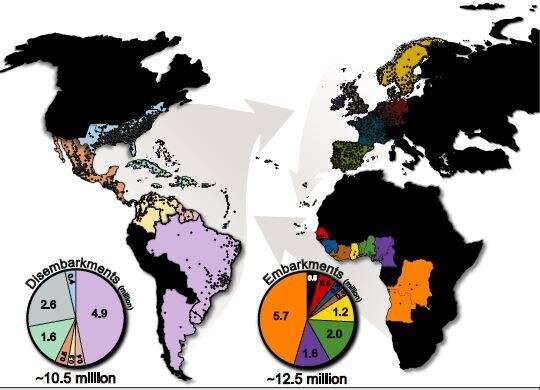Reexamining the history of slavery through 23andMe African ancestry data


The effects of the forced deportation of over 10 million African people during the transatlantic slave trade remain entrenched in the DNA of people from North, Central, and South America as well as the Caribbean. Now, in a paper appearing July 23 in the American Journal of Human Genetics, researchers have compiled genetic data from consenting 23andMe research participants to paint a more complete picture of African ancestry in the New World. By linking genetic data with historical records of the slave trade, the findings reinforce harsh truths about slavery in the Americas and uncover new insights into its marked history. These insights include the regions of Africa from which enslaved people were taken and the methods used to suppress and exploit Africans once they disembarked in the Americas.
“Our study combined the genetic data of more than 50,000 people on both sides of the Atlantic with historical records of enslaved people to create one of the most comprehensive investigations of the transatlantic slave trade,” says first author Steven Micheletti, a population geneticist at 23andMe. “One of the disturbing truths this research revealed was how the mistreatment of people with African ancestry shaped the current genetic landscape of African ancestry in the Americas.”
The researchers found that the genetic contributions from major African populations into the Americas match well with what they expected based on historical records, with most Americans of African descent having roots in Angola and Democratic Republic of the Congo. However, a closer look at precise African regions occasionally revealed a mismatch from what the researchers expected.
For instance, Nigerian ancestry is over-represented in African Americans in the U.S., likely due to the intra-continental slave trade, which the scientists say has only recently received attention for its impact on genetic variation. “By examining the Intra-American Slave Trade database, we concluded that much of the inferred Nigerian ancestry in the United States derives from transport of slaves within the Americas, primarily from the Caribbean,” says senior author Joanna Mountain, Senior Director of Research at 23andMe.
In contrast, researchers found that the genetic connections between African Americans and Senegambians were much lower than expected, given the number of Senegambians who disembarked in North America. “Because Senegambians were commonly rice cultivators in Africa, they were often transported to rice plantations in the US. These plantations were often rampant with malaria and had high mortality rates, which may have led to the reduced genetic representation of Senegambia in African Americans today,” Micheletti says.
Both slave-owner and government practices across the Americas had tremendous impacts on the distribution of African genetics as well. “Many slave-owners in the United States promoted enslaved people having children with one another for the purpose of maintaining a workforce, and even after slavery, they tended to segregate people of African descent,” says Micheletti. This is in contrast to practices in parts of Latin America, which supported “dilution” of the African populace after slavery was abolished. “In the early 1900s, sources state that the Brazilian government implemented immigration laws seeking to bring more Europeans into the country, presumably to have children with darker-skinned females and reduce African ancestry.” This practice of ‘dilution’ is one reason the researchers believe that the proportion of people with greater than 5% African ancestry is five times lower in Latin America than in the US, despite Latin America receiving roughly 70% of all disembarked African slaves.
In Latin America, this dilution practice also partially explains why African women are found to have contributed substantially more to the gene pool than did African men. “Our analysis estimated about 15 African women had children for each African man in Central and South America, as well as the Latin Caribbean,” says Micheletti. This female gene bias is found in North America as well, concordant with reports of generations of sexual exploitation of African women occurring ubiquitously across the Americas. Mountain points out that, “The female bias is particularly shocking given that the majority of enslaved individuals were male.”
Source: Read Full Article